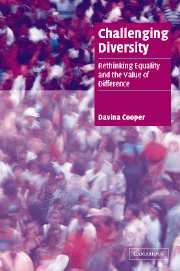Book contents
- Frontmatter
- Contents
- Acknowledgments
- 1 Introduction: mapping the terrain
- 2 Diversity politics: beyond a pluralism without limits
- 3 From blokes to smokes: theorising the difference
- 4 Towards equality of power
- 5 Normative encounters: the politics of same-sex spousal equality
- 6 Getting in the way: the social power of nuisance
- 7 Oppositional routines: the problem of embedding change
- 8 Safeguarding community pathways: ‘possibly the happiest school in the world’ and other porous places
- 9 Diversity through equality
- Bibliography
- Index
- Cambridge Cultural Social Studies
6 - Getting in the way: the social power of nuisance
Published online by Cambridge University Press: 22 September 2009
- Frontmatter
- Contents
- Acknowledgments
- 1 Introduction: mapping the terrain
- 2 Diversity politics: beyond a pluralism without limits
- 3 From blokes to smokes: theorising the difference
- 4 Towards equality of power
- 5 Normative encounters: the politics of same-sex spousal equality
- 6 Getting in the way: the social power of nuisance
- 7 Oppositional routines: the problem of embedding change
- 8 Safeguarding community pathways: ‘possibly the happiest school in the world’ and other porous places
- 9 Diversity through equality
- Bibliography
- Index
- Cambridge Cultural Social Studies
Summary
In this chapter I continue my exploration of the relationship between social norms and organising principles of inequality. Chapter 5 considered this interface through the lens of law reform. It examined the ways in which the legal pursuit of greater gay equality was structured in its meaning and effects by norms of proper place and the public/private divide. Here, I want to continue with this critique. Moving on from law reform, I focus in this chapter on the role played by particular injury-based discourses and remedies.
Discourses of injury are central to the wider themes of this book, namely the relationship between equality and diversity politics. What counts as harm structures the forms of diversity seen as legitimate subjects for equality. In other words, for many, ‘causing harm’ is the basis for distinguishing smokers' struggles against discrimination from those of women. Yet, this confident distinction is not as easy to sustain as it first appears. What we think of as harmful in the first place is structured by social inequalities and values; it is not a neutral category. This can be seen in the repertoire of ‘multicultural debates’ played out over circumcision, veiling and religious slaughter. It can also be seen in the conflicts between gay activists and orthodox Christians over employment rights. Do Christian organisations opposed to homosexuality ‘harm’ gay men and lesbians when they refuse to employ them? Are Christian bodies ‘harmed’ by being legally forced to employ people who live in ways that they fundamentally abhor?
- Type
- Chapter
- Information
- Challenging DiversityRethinking Equality and the Value of Difference, pp. 118 - 141Publisher: Cambridge University PressPrint publication year: 2004



